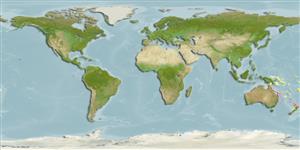Environment: milieu / climate zone / depth range / distribution range
Ekologi
marina bottenlevande; djupintervall 135 - 180 m (Ref. 7434). Tropical
Southwest Pacific: Endemic to Australia.
Size / Vikt / Age
Maturity: Lm ? range ? - ? cm
Max length : 19.3 cm SL hane/ej könsbestämd; (Ref. 7434)
Short description
Bestämningsnycklar | Morfologi | Morfometri
Taggstrålar i ryggfenan (totalt) : 0; Mjukstrålar i ryggfenan (totalt) : 16; Taggstrålar i analfenan: 0; Mjukstrålar i analfenan: 10; Ryggkotor: 42 - 43.
A benthic species (Ref. 75154) which occurs over soft bottoms of the continental shelf (Ref. 7300, 75154).
Life cycle and mating behavior
Könsmognad | Reproduktion | Lek | Ägg | Fecundity | Larver
Paxton, J.R. and V.H. Niem, 1999. Aulopidae: aulopus. p. 1919-1920. In K.E. Carpenter and V.H. Niem (eds.) FAO species identification guide for fishery purposes. The living marine resources of the Western Central Pacific. Vol. 3. Batoid fishes, chimaeras and bony fishes. Part 1 (Elopidae to Linophrynidae). FAO, Rome. (Ref. 39808)
IUCN Red List Status (Ref. 130435: Version 2024-1)
Threat to humans
Harmless
Human uses
Verktyg
Special reports
Download XML
Internet-källor
Estimates based on models
Preferred temperature (Ref.
123201): 19.8 - 23.3, mean 21.1 °C (based on 7 cells).
Phylogenetic diversity index (Ref.
82804): PD
50 = 0.5020 [Uniqueness, from 0.5 = low to 2.0 = high].
Bayesian length-weight: a=0.00447 (0.00186 - 0.01072), b=3.12 (2.91 - 3.33), in cm total length, based on LWR estimates for this (Sub)family-body shape (Ref.
93245).
Trofisk nivå (Ref.
69278): 3.9 ±0.6 se; based on size and trophs of closest relatives
Fishing Vulnerability (Ref.
59153): Low vulnerability (14 of 100).
